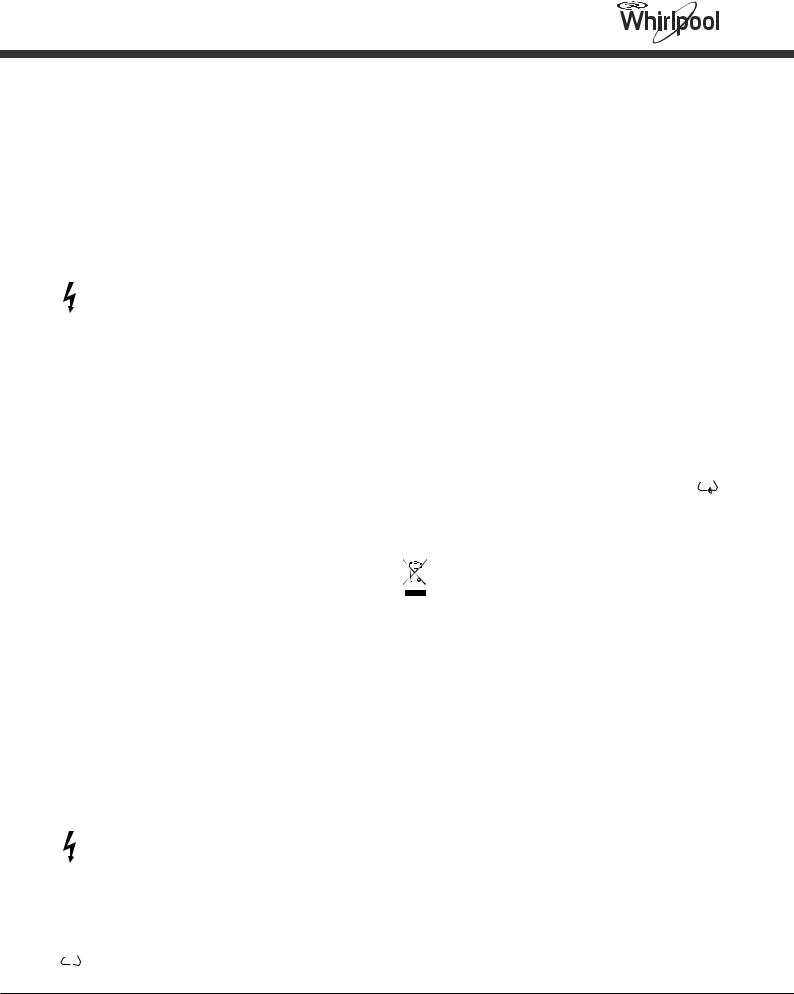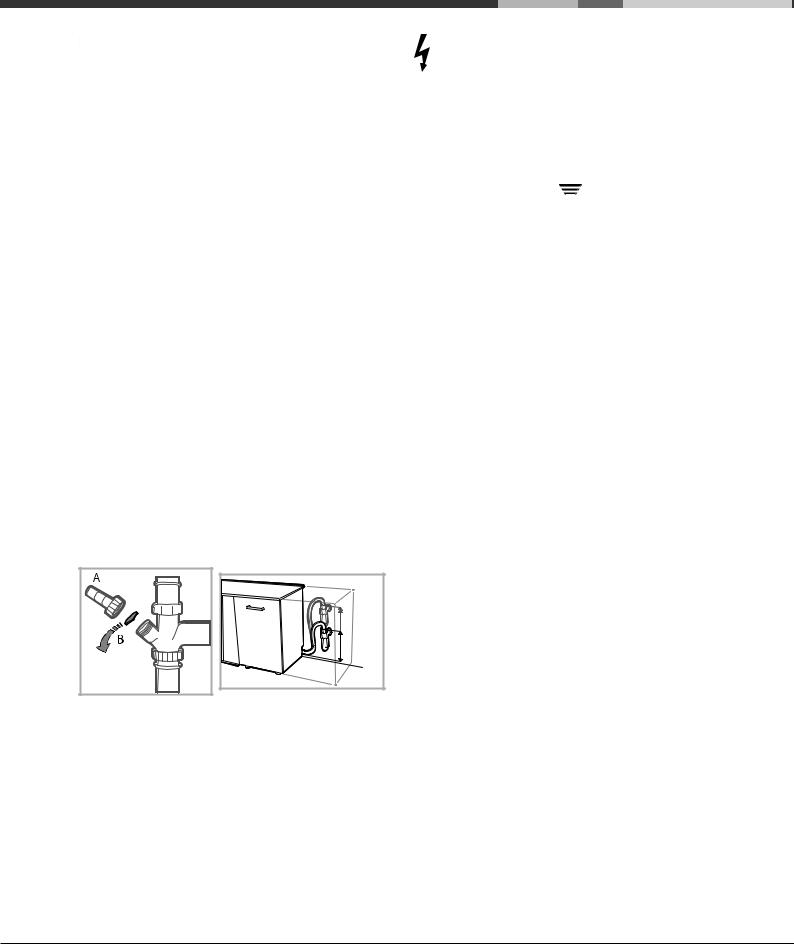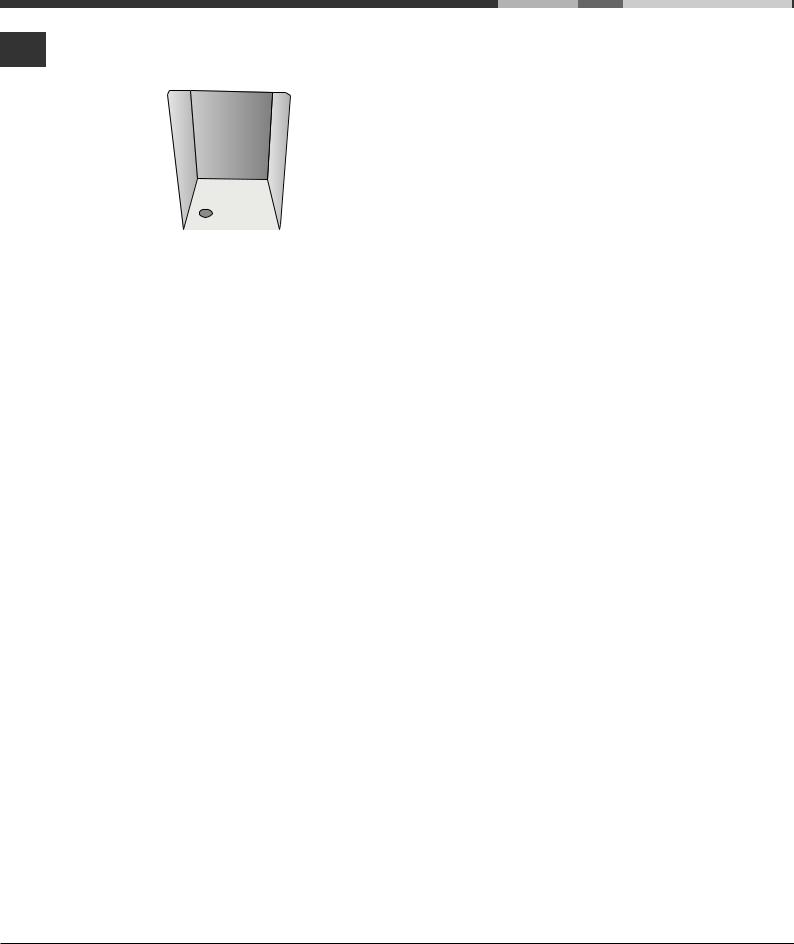WHIRLPOOL ADG 361 User Manual

ADG 361
EN English
Operating instructions
DISHWASHER - Contents
Operating instructions,1 Important Safety Instructions, 2-3 Assistance, 6
Product Data, 7
Installation, 8-9
Description of the appliance, 10 Refined salt and rinse aid, 11 Loading the racks, 12-13 Detergent and dishwasher use, 14 Wash cycles, 15
Special wash cycles and Options, 16 Care and maintenance, 17 Troubleshooting, 18
FR Français
Mode d’emploi
LAVE-VAISSELLE - Sommaire
Mode d’emploi, 1
Informations de Sécurité Importantes, 4-5 Service, 6
Fiche produit, 7 Installation, 19-20 Description de l’appareil, 21
Sel régénérant et Produit de rinçage, 22 Charger les paniers, 23-24
Produit de lavage et utilisation du lave-vaisselle, 25 Programmes, 26
Programmes spéciaux et Options, 27 Entretien et soin, 28
Anomalies et remèdes, 29

LEGEND OF SYMBOLS/LÉGENDE DES SYMBOLES
 Warning/Avertissement
Warning/Avertissement  Grounding/Mise à la terre
Grounding/Mise à la terre
 Electrical Hazard/Risque d’électrocution
Electrical Hazard/Risque d’électrocution
 Waste/Déchet
Waste/Déchet
 Safeguarding the environment/Protection de l’environnement
Safeguarding the environment/Protection de l’environnement
Recycling/Recyclage
 Use gloves/Utiliser des gants
Use gloves/Utiliser des gants
IMPORTANT SAFETY INSTRUCTIONS
 Read the instructions carefully before using, as they include important information on safe installation, use and maintenance. Keep this instruction manual in a safe place for future reference. If the appliance is sold, given away or moved, make sure the manual is kept with the machine.
Read the instructions carefully before using, as they include important information on safe installation, use and maintenance. Keep this instruction manual in a safe place for future reference. If the appliance is sold, given away or moved, make sure the manual is kept with the machine.
Remove the appliance from all packaging and make sure it was not damaged during transportation, if it was damaged contact the retailer and do not proceed any further with the installation process.
 When using your dishwasher, follow the precautions listed below:
When using your dishwasher, follow the precautions listed below:
• The appliance must be used to wash domestic crockery in accordance with the instructions in this manual.
• This appliance can be used by children aged from 8 years and above and persons with reduced physical, sensory or mental capabilities or lack of experience and knowledge if they have been given supervision or instruction concerning use of the appliance in a safe way and understand the hazards involved. Children shall not play with the appliance.
• Cleaning and user maintenance shall not be made by children without supervision.
• The appliance must not be installed outdoors, even in covered areas. It is extremely dangerous to leave the machine exposed to rain and storms.
• Do not store flammable materials in close proximity to the appliance.
• The water in the appliance is not potable.
• Do not use solvents inside the appliance: risk of explosion!
• The door should not be left in the open position since this could present a tripping hazard.
• Do not rest objects on the open door or sit or stand on it since the appliance could trip forward.
• The open appliance door can only support the weight of the loaded rack when pulled out.
• The water supply tap must be shut off and the plug should be removed from the electrical socket at the end of every cycle and before cleaning the appliance for carrying out any maintenance work also disconnect in the event of any malfunction.
• Repairs and technical modifications must be carried out exclusively by a qualified technician.
• When unplugging the appliance always pull the plug from the mains socket. Do not pull on the cable.
 • In order to avoid laceration hazard, usage of special gloves is needed during the assembling of the appliance.
• In order to avoid laceration hazard, usage of special gloves is needed during the assembling of the appliance.
• During use, the access to the rear wall should be limited in a sustainable manner such as approaching the device to the wall or furniture board.
• Keep packaging materials out of the reach of Children, packaging materials should not be used as a toy.
• Children must not be allowed to play with the appliance.
• Store the detergent, rinse aid and salt out of the reach of children.
• Appliance is dedicated only for household
use.
• Appliance can not be operated until installation process is complete.
 GROUNDING INSTRUCTIONS
GROUNDING INSTRUCTIONS
•This appliance must be grounded. In the event of a malfunction or breakdown, grounding will reduce the risk of an
2

electric shock by providing a path of least resistance of electric current. This appliance is equipped with a cord having an equipmentgrounding conductor and a grounding plug.
• The plug must be plugged into an appropriate outlet that is installed and grounded in accordance with all local codes and ordinances.
• Extension cord, adapters and conversion plugs must not be used to connect the appliance to the outlet.
• Improper connection of the equipmentgrounding conductor can result in the risk of an electric shock.
• Check with a qualified electrician or service representative if you are in doubt whether the appliance is properly grounded. Do not modify the plug provided with the appliance; If it does not fit the outlet. Have a proper outlet installed by a qualified electrician.
PROPER USE
• Access to disconnection of the appliance
(main plug) shall be ensured after installation.
• When loading items to be washed:
1 - Locate sharp items so that they are not likely to damage the door seal;
2 - WARNING: Knives and other utensils with sharp points must be loaded in the cutlery basket with their points/blades down or placed in a horizontal position with the sharp end facing away from the front of the appliance.
• Use only detergent and rinse additives designed for an automatic dishwasher.
• WARNING: Some dishwasher detergents are strongly alkaline. They can be extremely dangerous if swallowed. Avoid contact with the skin and eyes and keep children away from the dishwasher when the door is open. Check that the detergent receptacle is empty after completion of the wash cycle.
• If the supply cord is damaged, it must be replaced by the manufacturer or its service agent or a similarly qualified person in order to avoid a hazard.
• During installation, the power supply must not be excessively or dangerously bent or flattened. Do not tamper with controls.

 • To dispose of any packaging materials,
• To dispose of any packaging materials,
 follow local legislation so that the
follow local legislation so that the
packagings may be reused.
• Use the dishwasher only for its intended function.
• The appliance is to be connected to the water mains using new hose sets. The old hose-sets should not be reused.
• The maximum number of place settings is shown in the product sheet.
 SAFEGUARDINGTHEENVIRONMENT
SAFEGUARDINGTHEENVIRONMENT
• This appliance has been made of recyclable or re-usable material. Scrapping must be carried out in compliance with local waste disposal regulations. Before scrapping it, make sure to cut off the mains cord so that the appliance cannot be re-used.
•For more detailed information on handling and recycling of this product, contact your local authorities who deal with the separate collection of rubbish or the shop where you bought the appliance.
SCRAPPING OF PACKAGING
•The packaging can be 100% recycled as confirmed by the recycling symbol 
 . The various parts of the packaging must not be dispersed in the environment, but must be scrapped in line with local authority regulations.
. The various parts of the packaging must not be dispersed in the environment, but must be scrapped in line with local authority regulations.
• The European Directive 2012/19/EU relating to Waste Electrical and Electronic Equipment (WEEE) states that household appliances should not be disposed of using the normal solid urban waste cycle. Exhausted appliances should be collected separately in order to optimise the cost of reusing and recycling the materials inside the machine, while preventing potential damage to the atmosphere and public health. The crossed-out dustbin symbol shown on all products reminds the owners of their obligations regarding separated waste collection. For further information relating to the correct disposal of household appliances, owners may contact the relevant public authority or
the local appliance dealer.
3

FR INFORMATIONS DE SÉCURITÉ IMPORTANTES
 Lire attentivement les consignes avant toute utilisation. Elles contiennent des informations importantes pour une installation, une utilisation et un entretien en toute sécurité. Conserver ce manuel en lieu sûr pour une consultation future. Si l’appareil est vendu, donné ou déplacé, le manuel devra l’accompagner.
Lire attentivement les consignes avant toute utilisation. Elles contiennent des informations importantes pour une installation, une utilisation et un entretien en toute sécurité. Conserver ce manuel en lieu sûr pour une consultation future. Si l’appareil est vendu, donné ou déplacé, le manuel devra l’accompagner.
Déballer complètement l’appareil et vérifiez si le transport ne l’a pas endommagé. Le cas échéant, contacter le revendeur et interrompre l’installation.
 Pour utiliser le lave-vaisselle, suivre les précautions suivantes :
Pour utiliser le lave-vaisselle, suivre les précautions suivantes :
• L’appareil doit être utilisé pour le lavage de la vaisselle domestique conformément aux consignes figurant dans ce manuel.
• L’appareilpeutêtreutilisépardesenfantsde plus de 8 ans et des personnes présentant des capacités physiques, sensorielles ou mentales limitées, voire dépourvues de l’expérience et des connaissances nécessaires, sous surveillance et après avoir reçu les instructions nécessaires quant à l’utilisation de l’appareil en toute sécurité. Une compréhension des risques est également nécessaire. Les enfants ne sont pas autorisés à jouer avec l’appareil.
• Les enfants ne sont pas autorisés à nettoyer ni effectuer l’entretien de l’appareil sans surveillance.
• Ne pas installer l’appareil à l’extérieur, même dans un endroit protégé. Il est extrêmement dangereux de l’exposer à la pluie et aux orages.
• Ne p as conserver de matériaux inflammables à proximité de l’appareil.
• L’eau dans l’appareil n’est pas potable.
• Ne pas utiliser de solvants dans l’appareil:
risque d’explosion !
• Ne pas laisser la porte ouverte, car elle présente un danger de trébuchement.
• Ne rien poser sur la porte ouverte. Ne pas s’asseoir ni monter sur la porte car la machine pourrait basculer.
• Ouverte, la porte de la machine ne peut supporter que le poids du tiroir rempli.
• Le robinet d’alimentation en eau doit
être fermé et la fiche enlevée de la prise électrique au terme de chaque cycle et avant le nettoyage de l’appareil en vue des
travaux d’entretien. Débrancher également en cas de dysfonctionnement.
• Seul un technicien qualifié est apte à effectuer les réparations et les modifications techniques.
• Pour débrancher l’appareil, toujours extraire la fiche de la prise principale. Ne pas tirer sur le câble.
 • Pour éviter tout risque de coupure, l’utilisation de gants spéciaux est nécessaire pour l’assemblage de l’appareil.
• Pour éviter tout risque de coupure, l’utilisation de gants spéciaux est nécessaire pour l’assemblage de l’appareil.
• Pendant l’utilisation, l’accès à la paroi arrière doit être limité de façon durable, en rapprochant par exemple la machine du mur ou d’un meuble.
• Conserver les matériaux d’emballage hors de portée des enfants. Les emballages ne sont pas des jouets.
• Les enfants ne sont pas autorisés à jouer avec l’appareil.
• Ranger les produits de nettoyage, de rinçage et le sel hors de portée des enfants.
• La machine est conçue pour un usage domestique exclusivement.
• L’appareil ne peut pas être utilisé avant que
l’installation ait été menée à terme.
 CONSIGNES DE MISE À LA TERRE
CONSIGNES DE MISE À LA TERRE
•Cet appareil doit être mis à la terre.
En cas de dysfonctionnement ou de panne, une prise de terre réduit le risque d’électrocution en permettant au courant électrique de suivre un chemin de moindre résistance. Cet appareil est doté d’un cordon comportant un conducteur de terre et d’une fiche de mise à la terre.
•La fiche doit être branchée sur une prise de courant compatible, installée et mise à la terre conformément aux codes et règlementations en vigueur dans le pays.
•Éviter les allonges et les adaptateurs pour relier la machine à la prise.
• Un mauvais branchement du conducteur de terre de l’appareil peut entraîner un risque d’électrocution.
• En cas de doute, consulter un électricien qualifié ou un préposé du service pour s’assurer que l’appareil est correctement misàlaterre.Nepasmodifierlafichefournie avec l’appareil si elle n’est pas compatible avec la prise de courant. Demander à un électricien qualifié d’installer une prise adaptée.
4

UTILISATION APPROPRIÉE
• L’accès à la prise principale doit être assuré au terme de l’installation afin de pouvoir débrancher la machine le cas échéant.
• Pour charger l’appareil:
1 - Placer les objets coupants de sorte à ne pas endommager le joint de la porte.
2 - AVERTISSEMENT: Les couteaux et les autres utensiles présentant des pointes coupantes doivent être placés dans le panier à couverts. Les pointes et lames doivent être orientées vers le bas ou placées à l’horizontale. La partie coupante doit être tournée vers l’arrière de la machine.
• Utiliser uniquement des produits de lavage et de rinçage pour lave-vaisselle automatique.
• AVERTISSEMENT: Certains produits de lavage pour lave-vaisselle sont très alcalins. Ils peuvent s’avérer extrêmement dangereux en cas d’ingestion. Éviter tout contact avec la peau et les yeux et tenir les enfants à l’écart de l’appareil lorsque la porte est ouverte. Vérifier que le bac de produit de lavage est vide une fois le cycle de lavage achevé.
• Si le cordon d’alimentation est endommagé, il doit être remplacé par le fabricant, son agent d’entretien ou une personne aux qualifications identiques pour éviter tout danger.
• Pendant l’installation, l’alimentation
électrique ne doit pas subir des déformations ou un aplatissement excessifs ou dangereux. Ne pas altérer les commandes.
• Pour éliminer les matériaux d’emballage, respecter la législation
locale en termes de recyclage.
• Utiliser l’appareil uniquement pour l’usage auquel il est destiné.
• Lamachinedoitêtrereliéeàunealimentation d’eau à l’aide de tuyaux neufs. Les tuyaux usagés doivent être évités.
• Le nombre maximal de couverts pour lequel la machine est prévue figure dans la fiche produit.
 PROTECTIONDEL’ENVIRONNEMENT
PROTECTIONDEL’ENVIRONNEMENT
• La machine a été fabriquée à partir de matériaux recyclables ou réutilisables. La mise au rebut doit être réalisée conformément à la législation locale en la
matière. Avant la mise au rebut, veillez à couper le cordon d’alimentation pour éviter toute réutilisation de l’appareil.
• Pour de plus amples informations sur la prise en charge et le recyclage de ce produit, contactez les autorités locales compétentes en termes de tri sélectif ou votre revendeur.
MISE AU REBUT DE L’EMBALLAGE
• L’emballage peut être intégralement recyclé, comme l’indique le symbole Recyclable. Les différentes parties de l’emballage ne doivent pas être dispersées dans la nature, mais mise au rebut conformément à la législation locale.
• La Directive européenne 2012/19/EU relative aux déchets d’équipements électriques et électroniques (DEEE) stipule que les appareils domestiques doivent faire l’objet d’une collecte séparée de celle des déchets domestiques. Les appareils en fin de vie doivent être collectés séparément afin d’optimiser le coût de réutilisation et de recyclage des matériaux composant la machine tout en évitant les effets néfastes pour l’atmosphère et la santé publique. Le symbole représentant une poubelle sur roues barrée d’une croix rappelle aux utilisateurs leurs obligations en termes de tri sélectif. Pour plus d’informations quant à la mise au rebut correcte des appareils domestiques, les propriétaires sont invités à prendre contact avec les autorités publiques compétentes
ou leur revendeur.
5

EN Assistance
Before contacting Assistance:
•Check whether the problem can be resolved using the
Troubleshooting guide (see Troubleshooting).
•Restart the programme to check whether the problem has ceased to exist.
•If the problem persists, contact the Authorised Technical
Assistance Service.
 Never use the services of unauthorised technicians. Please have the following information to hand:
Never use the services of unauthorised technicians. Please have the following information to hand:
•The type of malfunction.
•The appliance model (Mod.).
•The serial number (S/N).
This information can be found on the appliance data plate (see Description of the appliance).
FR Service
Avant d’appeler le service d’assistance technique:
•Vérifier s’il est possible de résoudre l’anomalie soi-même (voir Anomalies et remèdes).
•Faire repartir le programme pour s’assurer que l’inconvénient a été résolu.
•Si ce n’est pas le cas, contacter un Service d’Assistance
Technique agréé.
 Ne jamais faire appel à des techniciens non agréés. Communiquer:
Ne jamais faire appel à des techniciens non agréés. Communiquer:
•le type d’anomalie;
•le modèle de l’appareil (Mod.);
•le numéro de série (S/N).
Ces informations figurent sur la plaque signalétique apposée sur l’appareil (voir Description de l’appareil).
6

EN Product Data (product fiche)
Product Fiche |
|
Brand |
WHIRLPOOL |
Model |
ADG 361 |
Rated capacity in standard place settings (1) |
10 |
Energy efficiency class on a scale from A+++ (low consumption) to D (high consumption) |
A+ |
Energy consumption per year in kWh (2) |
237 |
Energy consumption of the standard cleaning cycle in kWh |
0.83 |
Power consumption of the off-mode in W |
0.5 |
Power consumption of the left-on mode in W |
5.0 |
Water consumption per year in litres (3) |
2520 |
Drying efficacy class on a scale from G (low efficacy) to A (high efficacy) |
A |
Programme time for standard cleaning cycle in minutes |
180 |
The duration of the left-on mode in minutes |
12 |
Noise in dB(A) Re 1pW |
48 |
Built-in model |
Yes |
NOTES |
|
1) The information on the label and fiche relates to the standard cleaning cycle, this programme is suitable to clean normally soiled tableware and it is the most efficient programme in terms of combined energy and water consumption. The standard cleaning cycle corresponds to the Eco cycle.
2) Based on 280 standard cleaning cycles using cold water fill and the consumption of the low power modes. Actual energy consumption depends on how the appliance is used.
3) Based on 280 standard cleaning cycles. Actual water consumption depends on how the appliance is used.
FR Fiche de produit
Fiche de produit
Marque |
WHIRLPOOL |
Modèle |
ADG 361 |
Capacité nominale dans un environnement standard (1) |
10 |
Classe énergétique sur une échelle de A+++ (faible consommation) à D (consommation élevée) |
A+ |
Consommation d''énergie par année en kWh (2) |
237 |
Consommation d''énergie du cycle de lavage standard en kWh |
0.83 |
Consommation d''energie en mode "off" en W |
0.5 |
Consommation d''energie en mode "on" en W |
5.0 |
Consommation d''eau par an en litres (3) |
2520 |
Classe d’efficacité du séchage sur une échelle de G (efficacité minimum) à A (efficacité maximum) |
A |
Durée du programme pour un cycle de lavage standard en minutes |
180 |
Durée du mode "on" en minutes |
12 |
Émissions acoustiques dans l’air, exprimées en dB(A) re 1 pW |
48 |
Encastrable |
Oui |
NOTES
1) Les informations sur l’étiquette et sur la fiche se rapportent au cycle de lavage standard. Ce programme convient pour laver une vaisselle normalement sale, et il s’agit des programmes les plus efficaces en termes de consommation combinée d’eau et d’énergie. Le cycle de lavage standard correspond au cycle éco.
2) Sur la base de 280 cycles de lavage standard avec une alimentation en eau froide et une consommation en modes à faible puissance. La consommation réelle d’énergie dépend des conditions d’utilisation de l’appareil
3) Sur la base de 280 cycles de lavage standard. La consommation réelle d’énergie dépend des conditions d’utilisation de l’appareil.
7

Installation
EN |
|
|
If the appliance must be moved at any time, keep it in an |
|
|
||
|
upright position; if absolutely necessary, it may be tilted onto |
||
|
|
||
|
|
its back. |
|
Connecting the water supply
 Adaptation of the water supply for installation should only be performed by a qualified technician.
Adaptation of the water supply for installation should only be performed by a qualified technician.
The water inlet and outlet hoses may be positioned towards the right or the left in order to achieve the best possible installation.
Make sure the dishwasher does not bend or squash the hoses.
Connecting the water inlet hose
•To a 3/4” gas cold or hot water connection point (max.
60°C).
•Run the water until it is perfectly clear.
•Screw the inlet hose tightly into position and turn off the tap.
 If the inlet hose is not long enough, contact a specialist store or an authorised technician (see Assistance).
If the inlet hose is not long enough, contact a specialist store or an authorised technician (see Assistance).
 The water pressure must be within the values indicated in the Technical Data table - otherwise the dishwasher may be function properly.
The water pressure must be within the values indicated in the Technical Data table - otherwise the dishwasher may be function properly.
 Make sure the hose is not bent or compressed.
Make sure the hose is not bent or compressed.
Connecting the water outlet hose
Connect the outlet hose to a drain duct with a minimum diameter of 2 cm. (A)
The outlet hose connection must be at a height ranging from 40 to 80 cm from the floor or surface where the dishwasher rests.
MAX 80 cm |
MIN 40 cm |
Before connecting the water outlet hose to the sink drain, remove the plastic plug (B).
Anti-flooding protection
To ensure floods do not occur, the dishwasher:
- is provided with a special system which blocks the water supply in the event of anomalies or leaks from inside the appliance.
Some models are also equipped with the supplementary safety device New Acqua Stop, which guarantees antiflooding protection even in the event of a supply hose rupture.
WARNING: HAZARDOUS VOLTAGE!
Under no circumstances should the water inlet hose be cut as it contains live electrical parts.
Electrical connection
Before inserting the plug into the electrical socket, make
sure that: |
|
|
• The socket is earthed |
|
and complies with current |
|
||
regulations; |
|
|
•the socket can withstand the maximum load of the appliance as shown on the data plate located on the inside of the door
(see chapter Description of the appliance);
•The power supply voltage falls within the values indicated on the data plate on the inside of the door.
•The socket is compatible with the plug of the appliance. If this is not the case, ask an authorised technician to replace the plug (see Assistance). Do not use extension cables or multiple sockets.
 The cable should not be bent or compressed.
The cable should not be bent or compressed.
 If the power supply cable is damaged, have it replaced by the manufacturer or its authorised Technical Assistance Service in order to prevent all potential hazards. (See Assistance)
If the power supply cable is damaged, have it replaced by the manufacturer or its authorised Technical Assistance Service in order to prevent all potential hazards. (See Assistance)
 The Company shall not be held responsible for any incidents, if these regulations are not observed.
The Company shall not be held responsible for any incidents, if these regulations are not observed.
Positioning and levelling
1.Position the dishwasher on a level sturdy floor. If the floor is uneven, the front feet of the appliance may be adjusted until it reaches a horizontal position. If the appliance is levelled correctly, it will be more stable and much less likely to move or cause vibrations and noise while it is operating.
2.Before recessing the dishwasher, stick the adhesive transparent strip under the wooden shelf in order to protect it from any condensation which may form.
3.Place the dishwasher so that its sides or back panel are in contact with the adjacent cabinets or the wall. This appliance can also be recessed under a single worktop (see the Assembly instruction sheet).
4.To adjust the height of the rear foot, turn the red hexagonal bushing on the lower central part at the front of the dishwasher using a hexagonal spanner with an opening of 8 mm. Turn the spanner in a clockwise direction to increase the height and in an anticlockwise direction to decrease it. (see Building-in instruction sheet attached to the documentation)
8

Advice regarding the first wash cycle
After the installation, remove the stoppers from the racks and the retaining elastic elements from the upper rack (if any).
Water softener settings
Before starting the first wash cycle, set the hardness level of the water from the mains supply. (see chapter Rinse aid and refined salt).
First load the softener tank with water, then introduce about 1 kg of salt. It is perfectly normal for water to flow out.
As soon as this procedure is complete, run a wash cycle. Only use salt that has been specifically designed for dishwashers.
After the salt has been poured into the machine, the LOW SALT indicator light switches off.
 If the salt container is not filled, the water softener and the heating element may be damaged as a result.
If the salt container is not filled, the water softener and the heating element may be damaged as a result.
Technical data
Dimensions |
width 44,5 cm |
||
height 82 cm |
|||
|
|
|
depth 55 cm |
Capacity |
10 standard place-settings |
||
Water supply pressure |
0,05 ÷ 1MPa (0.5 ÷ 10 bar) |
||
7,25 psi – 145 psi |
|||
Power supply voltage |
See appliance data plate |
||
|
|
|
|
Total absorbed power |
See appliance data plate |
||
|
|
|
|
Fuse |
See appliance data plate |
||
|
|
|
This dishwasher conforms to the |
|
|
|
following European Community |
|
|
|
Directives: |
|
|
|
-93/68/EEC (CE Marking) |
|
|
|
-2006/95/EC (Low Voltage) |
|
|
|
-2004/108/EC (Electromagnetic |
|
|
|
Compatibility) |
|
|
|
-2009/125/EC (Comm. Reg. |
|
|
|
1016/2010) (Ecodesign) |
|
|
|
-2010/30/EC (Energy Labelling) |
|
|
|
-2011/65/EC (RoHS) |
|
|
|
-2012/19/CE Waste Electrical |
|
|
|
and Electronic Equipment (WEEE) |
|
|
|
|
|
|
|
|
|
|
|
|
The machine has a buzzer/set of tones to inform the user that |
|
||
EN |
|||
a command has been implemented: power on, cycle end etc. |
|||
|
|||
The symbols/indicator lights/LEDs on the control panel/ |
|
||
|
|||
display may vary in colour and may have a flashing or fixed |
|
||
light. |
|
||
The display provides useful information concerning the type |
|
||
of wash cycle, drying/wash-cycle phase, remaining time, |
|
||
temperature etc. |
|
||
9

Description of the appliance
EN |
Overall view |
|
1. Upper rack
2. Upper spray arm
3. Tip-up compartments
4. Rack height adjuster
5. Lower rack
6. Lower spray arm
7. Cutlery basket
8. Washing filter
9. Salt dispenser
10. Detergent and rinse aid dispensers
11. Data plate
12. Control Panel
Control panel
|
|
|
|
|
|
|
|
Low Salt |
||
|
|
|
|
|
|
|
|
indicator light |
||
|
Select Wash |
|
|
|
Wash-Cycle number |
|||||
|
|
|
||||||||
|
Cycle button |
|
|
|
and Remaining Time |
|||||
|
|
|
|
|
|
|
|
|
indicator |
|
ON/OFF/RESET |
|
|
|
|
|
|
|
|||
|
|
|
|
|||||||
button and |
|
|
|
|
|
|
Tablet Option button |
|||
indicator light |
|
|
|
|
|
|
and indicator light (Tab) |
|||
|
|
|
|
|
|
|
|
|
|
|
|
|
|
|
|
|
|
|
|
|
|
|
|
|
|
|
|
|
|
|
|
|
Low Rinse Aid |
Multizone |
indicator light |
Option button |
Start Delay Option |
Start Delay |
indicator light |
Option button |
|
Multizone Option indicator light |
10
